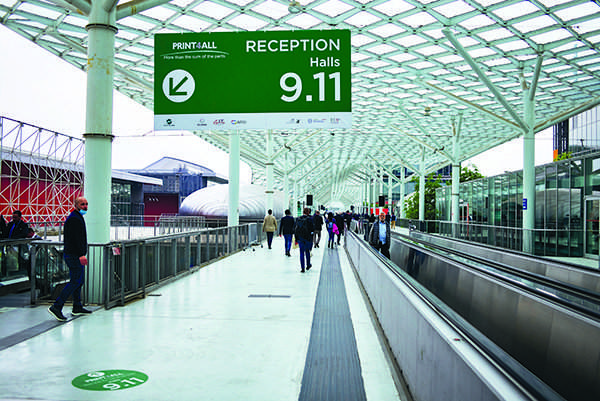As a general rule, most journalists look to construct a narrative out of an exhibition in order to pull all the announcements and interviews from the different vendors together into one coherent story. But I found it hard to do this at the recent Print4All show in Milan.
Now, that could be because I’m losing my touch, or that I’m just out of practice after the pandemic. Or it could be that it was mostly a local Italian show with little of international interest, which I think was really a missed opportunity, especially after Label Expo was cancelled. however, there just wasn’t any sense that all the vendors were on the same page.
Given that Print4All ran alongside several food and pharma processing and packaging shows, it might seem obvious that most vendors would concentrate on packaging-related print equipment. But there was quite a mish-mash with several label presses, both digital and flexo, as well as a few wide format printers and several Direct-to-Garment printers all mixed up with a number of commercial print-on-demand machines.
Most vendors didn’t bring any large equipment because it’s not cost effective to transport and assemble large machines for a four-day event. The result was that the main interest at the show for me was talking about machines and processes that weren’t being shown, which did seem like a somewhat counter-intuitive approach. Then again, we have all got on with life in the last two years, new processes have been developed and new machines introduced to the market. So now we are all playing catch-up in whatever way we can and the show was certainly useful from that point of view.
There did seem to be a lot of visitors to the event overall, which included iPack IMA, Pharmintech and GreenPlast, but I felt that the Print4All halls were a little less busy than some of the others. The vendors reported a mixed picture with some saying they had not seen many customers. But Mark Nixon, vice president for global sales and marketing at Scodix, pointed out that he saw the event primarily as raising brand awareness in the Italian market.

The Italian press manufacturer Lombardi used the show to introduce its new inkjet module, the Astra, which I’ve already covered in a separate story. This has been developed entirely in-house at Lombardi’s Brescia plant in Italy. It was shown running as a hybrid solution on a narrow web flexo press but marketing manager Nicola Lombardi says that it can be configured to cover print widths up to 600mm wide, which would allow it to also target some packaging applications.
Canon also had a brand new press – actually a prototype of the new V1000 – a dry toner commercial printer aimed mainly at print-on-demand and in-plant operations. Again, I’ve covered this separately though I think that it is interesting to see Canon returning to dry toner technology, having mainly concentrated on its inkjet devices in recent years.
Screen showed off its Truepress Jet L350UV SAI label press. This is not a new press, since it was initially announced at the last Label Expo, way back in 2019. But at the time Screen did not have a working model, so this was the first chance to see it at a show. The model on the stand was the entry-level E version though there are others in the range, including one with low migration ink for food packaging. Taishi Motoshige, marketing director for Screen Europe, said that Screen had two sales agreements in the first day.

Screen is also in the process of developing a wider web inkjet press for flexible films, the PacJet FL830, which should start beta testing later this year. Juan Cano, business development director for flexible packaging for Screen Europe, says that it’s a big machine and can handle a lot of volume but that the market is ready for this, noting, “There are certain changes from the pandemic that will stay. We are all buying a lot more from eCommerce and that will only grow. And the brand owners are using the packaging. They can change the content to match trends. We live in the Instagram and Twitter era and they want to embrace that communication through their packaging, and digital printing is the way to deliver that. And we are talking with brand owners to show them the capabilities of digital print in that area.”
Mark Nixon, Vice President for global sales and marketing at Scodix, agrees that the pandemic has forced many brands to refocus their efforts, “I think the supply chains of the brands were too long and they were caught with a lot of stuff they couldn’t move. So they want to on-shore it all now. They spent the last twenty years off-shoring it so the pandemic certainly aided that process. They all want to be reactive.”
Scodix showed off its B1-sized Ultra 6000 enhancement press. It will take sheets up to 760 x 1060 mm and can run at speeds of up to 1000 sph. It’s capable of a number of enhancements, including adding textures, foil, glitter and spot varnish, all without having to produce dies or lose time preparing for a range of separate finishes.

Nixon says that he sells this to the packaging market purely on the basis that it’s more cost effective to replace conventional processes with the digital machine, adding, “I want to sell the fact that they can do 30-40% of their work more economically. It’s all about economics but digital has a bad name in packaging and people automatically assume they can’t make money or that it’s not heavy duty enough. With Scodix, they are saving on makeready time and die cutting costs. And then on top of that we have all the sexy stuff like the foil on foil and so on. And it’s variable data, and the time to market is immediate.”
Xeikon also had a stand, though sadly no equipment. However, I did come across Sebastien Stabel, marketing manager for the Idera corrugated press that Xeikon is in the process of developing. He told me, “We have spent the time during covid fine-tuning the machine, focussing on the ink and the ink consumption, the wave form optimisation and we have improved the stacking and feeding.” The press can currently run coated stocks at 60mpm and 600 x 600 dpi resolution, as well as uncoated stocks at 90mpm at 600 x 600dpi and up to 120mpm at 400 x 600dpi.

At the moment it prints CMYK though there is room to add up to six color channels. Stabel says that Xeikon is still deciding on this, noting that the extra colors could be used to extend the color gamut, or that light cyan and light magenta could give better skin tones but notes, “However, we would be adding extra costs, and more heads would mean more complexity and servicing.”
Xeikon has no plans for now for a digital white ink, which would be more challenging with water-based inks, but there are inline modules for priming and varnishing, both using anilox. The latest samples do show a marked improvement over some of the older samples, which Stabel says is mostly down to better RIP’ing profiles and dot distribution, as well as switching from binary to greyscale. Xeikon is currently working with the older Kyocera KJB4 print heads. He says that Xeikon is testing alternatives but notes, “We see that 600dpi heads allows us to print 2.5mm above the sheet and gives us enough to hit this market. But the technology will evolve and everybody will print at 1200 dpi because things are getting better.”
Interestingly, he adds, “We are looking at flexible film for the future. The building blocks are being laid with the ink formulation and the idea of what else can we do with the ink that we are developing for the corrugated applications.” This makes sense since printing water-based inks to porous materials like corrugated is really the low hanging fruit that most vendors will see as a way of understanding the packaging market and a technical stepping stone to developing inkjet presses capable of handling the much more challenging flexible film packaging.

Konica Minolta shared a stand with MGI, which gave me a chance to talk about the AlphaJet, MGI’s B1 inkjet press that has been in development now for over a decade. The current incarnation is an all-in-one packaging press that can print graphics and enhancements to corrugated sheets as part of a single process. The whole machine is shaped like a square horseshoe and the sheets are transported on flat trays from one process to the next, starting from the feeder stack, going around the different processing stations and ending back up next to the feeder in a take-up stack.
The printing process uses Memjet DuraLink printheads combined with Memjet’s water-based inks. This gives it a maximum resolution of 1600 x 1600 dpi and will cover 90% of the Pantone range. From the printing stations, the trays then deliver sheets through a series of other processes, which can include spot coating, hot foiling and embossing with inline die cutting and creasing coming soon.
It will take sheets up to B1+ or 72 x 110cm. It can get through 18 B1 sheets per hour, which is not fast but Paul-Andre Fardo, deputy sales manager for MGI Europe, says the brands prefer to have all the effects together in a single process rather than faster speeds because it simplifies the production.So far one of these machines has been installed at a French beta site, ISRA Cards, which specializes in producing cards and customised media, as well as packaging. Even though it’s still at the beta stage, the samples that were shown in Milan did seem quite good. The price is likely to be around €2.5 million.

Actega Metal Print had a small stand to discuss its EcoLeaf concept, which does appear to have the potential to seriously disrupt the conventional foiling market. Essentially this uses aluminium flakes, which are produced by the same deposition process that’s used to make conventional foil sheets. But the flakes are suspended in a liquid solution. The advantage is that the foil is only applied where needed so that there’s none of the waste that’s usually generated from cutting the image out of the sheets. Any flakes that don’t stick to the image are scooped up and re-used.
The process relies on printing a trigger image, which can be done offline, via flexo, screen or digital. This image can then be sent past the EcoLeaf metallisation unit, where it attracts the flakes, which are applied as a very thin layer. For now, this process is only available for narrow web flexo presses but Jeffrey Shea, senior external consultant for Actega Metal Print, says that in the future it will also support wider web flexo and sheetfed offset.

I also caught up with Guido van der Schueren, chairman of Hybrid Software Group who seemed cautiously optimistic for the future, noting, “It takes time for business to get back in the rhythm.” He added, “People need to get out especially in the southern countries where you need face to face contact.”
Ultimately, for me, getting out and meeting people face to face was the main value from this event. In some ways, Print4All was frustrating. Quite a few of the vendors listed were not at the show – just a local distributor – which is not the same thing at all and gave the misleading impression that the show was supported by a wider range of vendors than was really the case.
The Fiera Milano fairground itself demonstrates a soaring architectural vision that was sadly compromised by security guards blocking every entrance and insisting visitors walk the long way around, which made it difficult to move between the different parts of the overall trade fair. A small amount of common sense or more signage would have greatly improved on this.
But apart from these minor issues, who could complain about a chance to visit Milan, from the sublime majesty of the Duomo cathedral and the buzz of the streets to the simple pleasure of a decent pizza – the city seemed to be recovering from the trauma of the last two years. No doubt as international travel returns we will all be able to get back into the rhythm.










